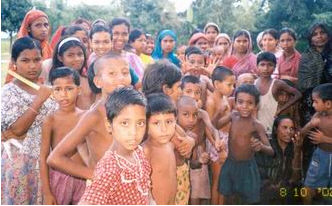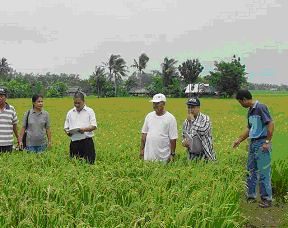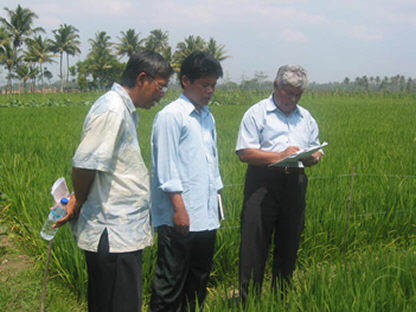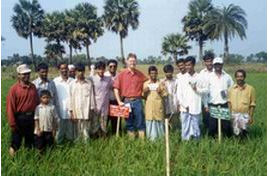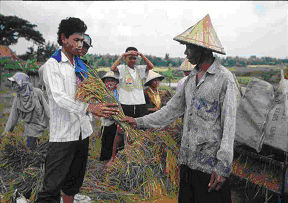How is FPR carried out?
 Planning Meeting
Planning Meeting
|
|
Initiate participatory experiments in collaboration with the local agricultural extension technician and the village head. In each village or district, invite 10 to 25 farmers. With the researcher acting as the facilitator, conduct group meetings with farmers. These half-day meetings can begin with general discussions about rice growing and related problems. Later, discussions should focus on the topic of relevance to both farmers and researchers. For instance, in pest management, the discussions may focus on a major pest (e.g., the rice leaffolder), concerns about damage by the pest, losses the pest could cause and methods of control. Encourage farmers to discuss whether the pest really needs control and if they think so, whether anyone would volunteer to participate in evaluating a simple treatment.
Planning: Researchers, local extension groups and farmers meet to discuss and plan activities. Be sensitive to gender and whether meetings should be for males, females or mixed gender groups.
 Laying out the experiment
Laying out the experiment
Each participating farmer would mark out an area of about 100 m2 in his or her field that would that would not receive any insecticide treatment in the first 30 days after transplanting. The rest of his or her field would receive normal treatments. All other agronomic practices in both the experiment and main plots would be according to each farmer's normal practice. During the cropping season, the extension technician and researcher will make at least one follow-up visit to each participant.
|
|
 Support materials
Support materials
Provide participating farmers with some support materials, such as follows:
- A signboard (30 cm x 60 cm) with the farmer's name, collaborating agencies and the experimental title for display in each participant's field.
- Comics strips depicting a discussion of a farmer who had done the experiment in local language.
- A cardboard file with weekly activity sheets and a ball-point pen for recording farming activities and input costs.
- A set of instructions to conduct farmer participatory research.
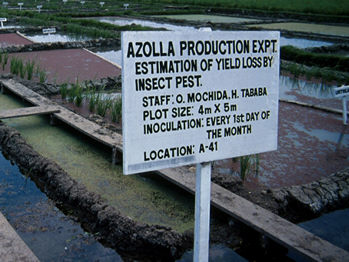
 Monitoring
Monitoring
Before the experiments begin, conduct a short pre-FPR or baseline survey primarily to allow subsequent comparison of yields and costs of the practice of interest (e.g., insecticide applications in the case of leaffolder) from the experimental and main plots. Determine their practices (e.g., insecticide use patterns), and knowledge and attitude towards the problem (e.g., leaf feeding insects). The second survey could focus on farmers practices, costs, perception of yield differences and benefits derived from applying the “new” treatment (e.g., not using early season insecticide sprays for leaffolder control).
|
|
 Farmer experience sharing workshop
Farmer experience sharing workshop
At the end of the season, organize a workshop where farmers will report their experimental results. Invite neighboring farmers and local extension technicians. Preferably a week before the workshop, help each participating farmer to prepare his report on the results. Have a one-page cost and yield comparison between treated and untreated plots. During the workshop encourage farmers to discuss possible reasons for yield differences and their plans for the next season.
As a token of appreciation, give each participant a t-shirt or a cap, a certificate of participation or picture (e.g., take pictures of the farmers with their experimental plots).
|
|
 Farmer-to-farmer spread
Farmer-to-farmer spread
To monitor diffusion, ask farmers in a monitoring survey for names and addresses of other farmers with whom they had directly shared the results of their experiments. Track down the farmers who heard about the experiment from the first group and had followed the simple rule that was tried out in FPR. If most of them are neighbors and relative, it could suggest that the spread may be through kinship and close proximity of their neighbors.
|
|
 Upscaling
Upscaling
With the help of media, such as newspapers, radio and television, spread may be further enhanced. The use of these approaches may be explored in the future. Since encouraging farmers to experiment with a simple rule-of-thumb can be easily communicated in informal talks, farmer-to-farmer spread of experiences from the experimentation may be further enhanced.
|
|
